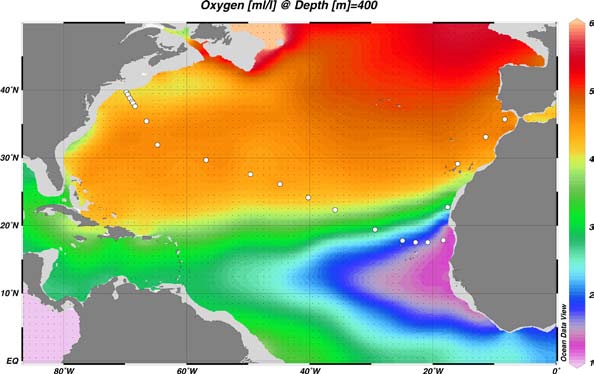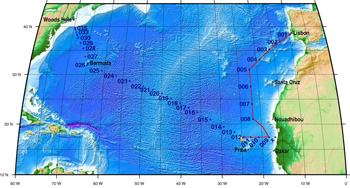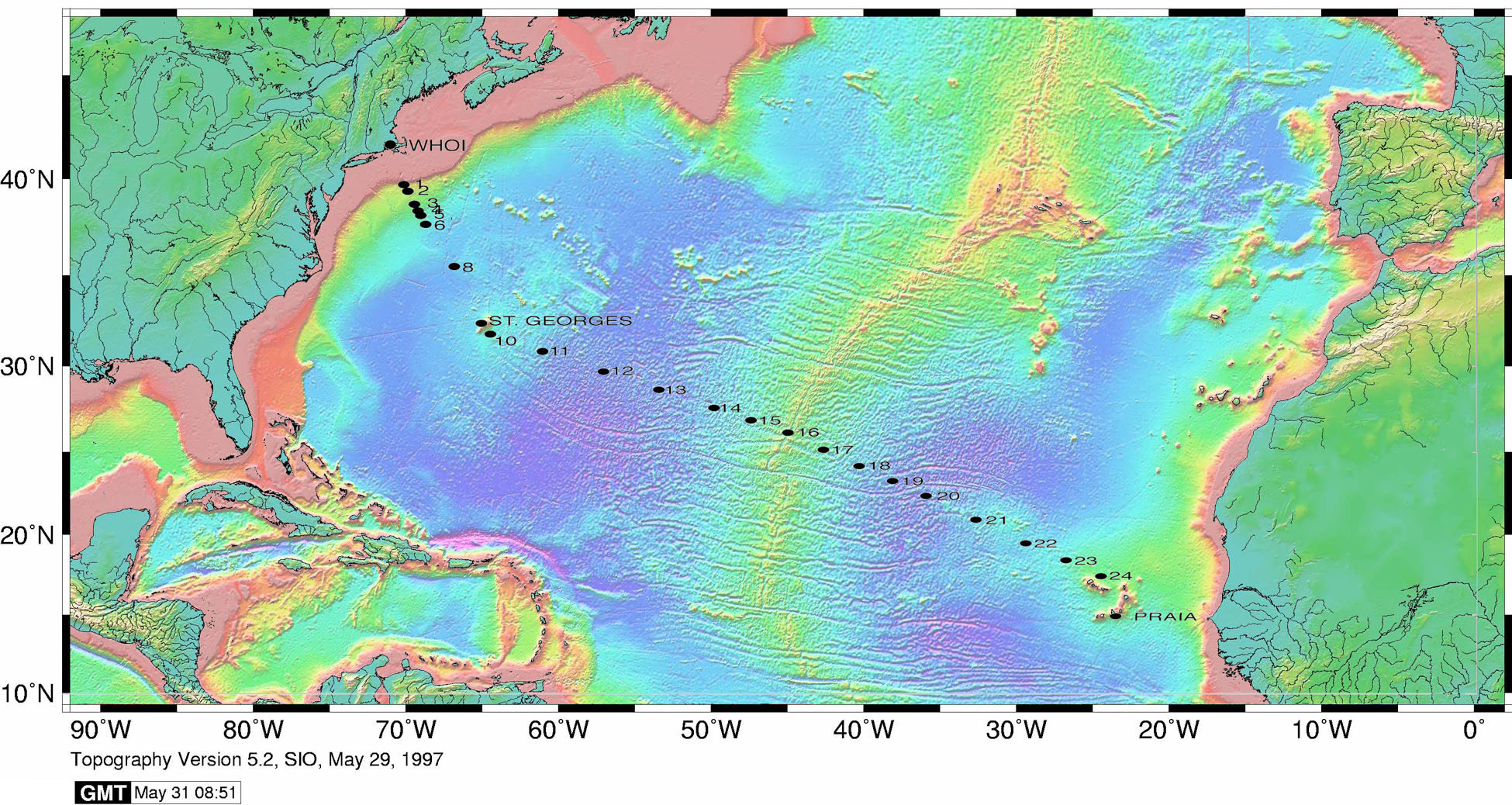Suspended particulate matter along US GEOTRACES North Atlantic Transect from the R/V Knorr KN199-04 cruise in the subtropical northern Atlantic Ocean in 2010 (U.S. GEOTRACES NAT project)
Project
Program
| Contributors | Affiliation | Role |
|---|---|---|
| Chaves, Joaquin | National Aeronautics and Space Administration (NASA) | Principal Investigator |
| McClain, Charles | National Aeronautics and Space Administration (NASA-JPL) | Co-Principal Investigator |
| Kinkade, Danie | Woods Hole Oceanographic Institution (WHOI BCO-DMO) | BCO-DMO Data Manager |
Abstract
Suspended particulate matter (SPM) on samples collected during Geotraces 2010 (KN199-04).
The following metadata was extracted from the original file header:
/begin_header
/investigators=Joaquin_Chaves
/affiliations=NASA
/contact=joaquin.chaves@nasa.gov
/experiment=GEOTRACES
/cruise=kn199-4
/station=NA
/data_file_name=kn199-4_SPM_NCODMO.csv
/documents=SPM_protocols.pdf
/calibration_files=missing_calibration.txt
/data_type=bottle
/data_status=final
/start_date=20101017
/end_date=20101102
/start_time=11:20:00[GMT]
/end_time=17:10:00[GMT]
/north_latitude=38.3296[DEG]
/south_latitude=17.3581[DEG]M
/east_longitude=-9.6604[DEG]
/west_longitude=-24.4962[DEG]
/water_depth=-999
/measurement_depth=-999
/secchi_depth=-999
/wind_speed=-999
/cloud_percent=-999
/wave_height=-999
!
! The field "replicates" indicates how many replicate samples were
! averaged to produce the reported value
NOTE: The following header line was incorrect and subsequently corrected by BCO-DMO
! sample_no==-999 were collected with NASA's surface peristaltic pump
! quality = 1 good; 2 = medium; 3 = poor
!
/missing=-999
/delimiter=comma
Sample collection
Water samples collected from surface pump are filtered under low vacuum (<5 in Hg) into pre-weighed (± 0.001 mg) 47mm, 0.2 um pore size Nucleopore polycarbonate filters. Before removal from filtering apparatus samples are rinsed with filtered seawater unless otherwise indicated. Filter samples with retained material from a known filtrate volume (± 1mL) are stored in plastic petri dish at -20°C (-80°C, if available) until processing in the laboratory.
Data Processing:
Data are averages of samples replicates, the number of which is indicated as a data column. Standard deviation of replicates is included as a data column as well. Data has been visually QA/QC. Suspended Particulate Matter (SPM) is calculated by subtracting the weight of the pre-weighed filter where the sample was collected on, to the average of the sample plus filter weights. Estimates of SPM are not corrected for salts retained in filter and retained material. Quality flags "quality", quality = 1, good; 2 = medium; 3 = poor. The latter are assigned based on the coefficient of variation (cv) of replicate samples:
quality(cv<0.1) = 1; % good
quality(cv>0.1) = 2; % medium
quality(cv>0.5) = 3; % poor
BCO-DMO Processing Notes:
Edits made:
- Parameter header names were renamed to BCO-DMO convention
- Blank data fields and data reported as -999 were edited to 'nd'
- Edited time to remove colons and drop unused seconds
- Edited precision of lat/lon to four decimals.
- Edited precision of SPM and SPM_sd to two decimals.
- Removed the comment information from the file header. Where
necessary the information was incorporated into BCO-DMO
metadata fields and retained entirely in Dataset Description.
NOTE: Correspondence with the PI (2013.01.12) regarding sample numbers indicates that samples with a GEOTRACES sample number also had pigment samples taken for the WHOI Thorium group. Those samples with -999 did not have corresponding pigment samples taken. Sample numbers of -999 were subsequently edited to 'nd' and the following comment was retained in the file header as per the PI:
#samples from station 1 were collected with WHOI's GEOTRACES pump
#sample numbers for stations > 1 were collected with NASA's
# surface peristaltic pump
Additional GEOTRACES Processing: After the data were submitted to the International Data Management Office, BODC, the office noticed that important identifying information was missing in many datasets. With the agreement of BODC and the US GEOTRACES lead PIs, BCO-DMO added standard US GEOTRACES information, such as the US GEOTRACES event number, to each submitted dataset lacking this information. To accomplish this, BCO-DMO compiled a 'master' dataset composed of the following parameters: station_GEOTRC, cast_GEOTRC (bottle and pump data only), event_GEOTRC, sample_GEOTRC, sample_bottle_GEOTRC (bottle data only), bottle_GEOTRC (bottle data only), depth_GEOTRC_CTD (bottle data only), depth_GEOTRC_CTD_rounded (bottle data only), BTL_ISO_DateTime_UTC (bottle data only), and GeoFish_id (GeoFish data only). This added information will facilitate subsequent analysis and inter comparison of the datasets.
Bottle parameters in the master file were taken from the GT-C_Bottle_GT10, GT-C_Bottle_GT11, ODF_Bottle_GT10, and ODF_Bottle_GT11 datasets. Non-bottle parameters, including those from GeoFish tows, Aerosol sampling, and McLane Pumps, were taken from the Event_Log_GT10 and Event_Log_GT11 datasets. McLane pump cast numbers missing in event logs were taken from the Particulate Th-234 dataset submitted by Ken Buesseler.
A standardized BCO-DMO method (called “join”) was then used to merge the missing parameters to each US GEOTRACES dataset, most often by matching on sample_GEOTRC or on some unique combination of other parameters.
If the master parameters were included in the original data file and the values did not differ from the master file, the original data columns were retained and the name of the parameters were changed from the PI-submitted names to the standardized master names. If there were differences between the PI-supplied parameter values and those in the master file, both columns were retained. If the original data submission included all of the master parameters, no additional columns were added, but parameter names were modified to match the naming conventions of the master file.
See the dataset parameters documentation for a description of which parameters were supplied by the PI and which were added via the join method.
| File |
|---|
SPM_GT10_joined.csv (Comma Separated Values (.csv), 1.14 KB) MD5:401d9921329b05cf6c22e2fce82434e4 Primary data file for dataset ID 3862 |
| Parameter | Description | Units |
| lat | Latitude component of geographic position where samples were collected. | decimal degrees |
| lon | Longitude component of geographic position where samples were collected. | decimal degrees |
| time_gmt | Time of sampling, reported in GMT. in the format hhmm | unitless |
| yrday_gmt | Year day recorded in GMT time, where Jan 1 is day 1. | unitless |
| date_gmt | Date, recorded in GMT time. in the format yyyymmdd | unitless |
| depth | Sample depth in meters. | meters |
| SPM | Suspended particulate matter. | mg/Liter |
| SPM_sd | Standard deviation of Suspended Particulate Matter (SPM) measurement. | mg/Liter |
| replicate | A number indicating how many replicate samples were averaged to produce the reported value. | dimensionless |
| SPM_qflag | Quality flag associated with Suspended Particulate Matter (SPM) measurement, where 1 = good; 2 = medium; 3 = suspect. | dimensionless |
| station_GEOTRC | GEOTRACES station number; ranges from 1 through 12 for KN199-04 and 1 through 24 for KN204-01. Stations 7 and 9 were skipped on KN204-01. PI-supplied values were identical to those in the intermediate US GEOTRACES master file. Originally submitted as 'station'; this parameter name has been changed to conform to BCO-DMO's GEOTRACES naming conventions. | dimensionless |
| cast_GEOTRC | Cast identifier numbered consecutively within a station. Values were added from the intermediate US GEOTRACES master file (see Processing Description). | dimensionless |
| event_GEOTRC | Unique identifying number for US GEOTRACES sampling events; ranges from 2001 to 2225 for KN199-04 events and from 3001 to 3282 for KN204-01 events. Values were added from the intermediate US GEOTRACES master file (see Processing Description). | dimensionless |
| sample_GEOTRC | Unique identifying number for US GEOTRACES samples; ranges from 5033 to 6078 for KN199-04 and from 6112 to 8148 for KN204-01. PI-supplied values were identical to those in the intermediate US GEOTRACES master file Originally submitted as 'sample'; this parameter name has been changed to conform to BCO-DMO's GEOTRACES naming conventions. | dimensionless |
| sample_bottle_GEOTRC | Unique identification numbers given to samples taken from bottles; ranges from 1 to 24; often used synonymously with bottle number. Values were added from the intermediate US GEOTRACES master file (see Processing Description). | dimensionless |
| bottle_GEOTRC | Alphanumeric characters identifying bottle type (e.g. NIS representing Niskin and GF representing GOFLO) and position on a CTD rosette. Values were added from the intermediate US GEOTRACES master file (see Processing Description). | dimensionless |
| depth_GEOTRC_CTD | Observation/sample depth in meters; calculated from CTD pressure. Values were added from the intermediate US GEOTRACES master file (see Processing Description). | meters |
| BTL_ISO_DateTime_UTC | Date and time (UTC) variable recorded at the bottle sampling time in ISO compliant format. Values were added from the intermediate US GEOTRACES master file (see Processing Description). This standard is based on ISO 8601:2004(E) and takes on the following form: 2009-08-30T14:05:00[.xx]Z (UTC time) | yyyy-MM-dd'T'HH:mm:ss.SS'Z' |
| cruise_id | cruise identifier | nd |
| Dataset-specific Instrument Name | Pump surface |
| Generic Instrument Name | Pump surface |
| Dataset-specific Description | NASA's surface peristaltic pump was used to collect some samples, others were collected with the WHOI surface pump (not trace metal clean, set up by
the Thorium group) |
| Generic Instrument Description | A source of uncontaminated near-surface seawater pumped onto the deck of the research vessel that can be sampled and analyzed. This pumped seawater supply is from an over-the-side pumping system, and is therefore different from the vessel underway seawater system. |
KN199-04
| Website | |
| Platform | R/V Knorr |
| Report | |
| Start Date | 2010-10-15 |
| End Date | 2010-11-04 |
| Description | This cruise constitutes the first survey section as part of the U.S. participation in an international program named GEOTRACES.
Funding: NSF OCE award 0926423
Science Objectives: To obtain state of the art trace metal and isotope measurements on a suite of samples taken on a mid-latitude zonal transect of the North Atlantic. In particular, sampling targeted the oxygen minimum zone extending off the west African coast near Mauritania, the TAG hydrothermal field, and the western boundary current system along Line W. For additional information, please refer to the GEOTRACES program Web site (https://www.geotraces.org/) for overall program objectives and a summary of properties measured.
Science Activities include seawater sampling via GoFLO and Niskin carousels, in situ pumping (and filtration), CTDO2 and transmissometer sensors, underway pumped sampling of surface waters, and collection of aerosols and rain. Hydrography, CTD and nutrient measurements were supported by the Ocean Data Facility (J. Swift) at Scripps Institution of Oceanography and funded through NSF Facilities. They provided an additional CTD rosette system along with nephelometer and LADCP. A trace metal clean Go-Flo Rosette and winch were provided by the group at Old Dominion University (G. Cutter) along with a towed underway pumping system.
Additional cruise information is available from the Rolling Deck to Repository (R2R): https://www.rvdata.us/search/cruise/KN199-04
Other Relevant Links:
List of cruise participants: [ PDF ]
Cruise track: JPEG image (from Woods Hole Oceanographic Institution, vessel operator)
ADCP data are available from the Currents ADCP group at the University of Hawaii: KN199-04 ADCP |
U.S. GEOTRACES North Atlantic Transect (GA03) (U.S. GEOTRACES NAT)
Much of this text appeared in an article published in OCB News, October 2008, by the OCB Project Office.
The first U.S. GEOTRACES Atlantic Section will be specifically centered around a sampling cruise to be carried out in the North Atlantic in 2010. Ed Boyle (MIT) and Bill Jenkins (WHOI) organized a three-day planning workshop that was held September 22-24, 2008 at the Woods Hole Oceanographic Institution. The main goal of the workshop, sponsored by the National Science Foundation and the U.S. GEOTRACES Scientific Steering Committee, was to design the implementation plan for the first U.S. GEOTRACES Atlantic Section. The primary cruise design motivation was to improve knowledge of the sources, sinks and internal cycling of Trace Elements and their Isotopes (TEIs) by studying their distributions along a section in the North Atlantic (Figure 1). The North Atlantic has the full suite of processes that affect TEIs, including strong meridional advection, boundary scavenging and source effects, aeolian deposition, and the salty Mediterranean Outflow. The North Atlantic is particularly important as it lies at the "origin" of the global Meridional Overturning Circulation.
It is well understood that many trace metals play important roles in biogeochemical processes and the carbon cycle, yet very little is known about their large-scale distributions and the regional scale processes that affect them. Recent advances in sampling and analytical techniques, along with advances in our understanding of their roles in enzymatic and catalytic processes in the open ocean provide a natural opportunity to make substantial advances in our understanding of these important elements. Moreover, we are motivated by the prospect of global change and the need to understand the present and future workings of the ocean's biogeochemistry. The GEOTRACES strategy is to measure a broad suite of TEIs to constrain the critical biogeochemical processes that influence their distributions. In addition to these "exotic" substances, more traditional properties, including macronutrients (at micromolar and nanomolar levels), CTD, bio-optical parameters, and carbon system characteristics will be measured. The cruise starts at Line W, a repeat hydrographic section southeast of Cape Cod, extends to Bermuda and subsequently through the North Atlantic oligotrophic subtropical gyre, then transects into the African coast in the northern limb of the coastal upwelling region. From there, the cruise goes northward into the Mediterranean outflow. The station locations shown on the map are for the "fulldepth TEI" stations, and constitute approximately half of the stations to be ultimately occupied.
Figure 1. The proposed 2010 Atlantic GEOTRACES cruise track plotted on dissolved oxygen at 400 m depth. Data from the World Ocean Atlas (Levitus et al., 2005) were plotted using Ocean Data View (courtesy Reiner Schlitzer). [click on the image to view a larger version]

Hydrography, CTD and nutrient measurements will be supported by the Ocean Data Facility (J. Swift) at Scripps Institution of Oceanography and funded through NSF Facilities. They will be providing an additional CTD rosette system along with nephelometer and LADCP. A trace metal clean Go-Flo Rosette and winch will be provided by the group at Old Dominion University (G. Cutter) along with a towed underway pumping system.
The North Atlantic Transect cruise began in 2010 with KN199 leg 4 (station sampling) and leg 5 (underway sampling only) (Figure 2).
Figure 2. The red line shows the cruise track for the first leg of the US Geotraces North Atlantic Transect on the R/V Knorr in October 2010. The rest of the stations (beginning with 13) will be completed in October-December 2011 on the R/V Knorr (courtesy of Bill Jenkins, Chief Scientist, GNAT first leg). [click on the image to view a larger version]

The section completion effort resumed again in November 2011 with KN204-01A,B (Figure 3).
KN204-01A,B Cruise Report (PDF)
Figure 3. Station locations occupied on the US Geotraces North Atlantic Transect on the R/V Knorr in November 2011. [click on the image to view a larger version]

Data from the North Atlantic Transect cruises are available under the Datasets heading below, and consensus values for the SAFe and North Atlantic GEOTRACES Reference Seawater Samples are available from the GEOTRACES Program Office: Standards and Reference Materials
ADCP data are available from the Currents ADCP group at the University of Hawaii at the links below:
KN199-04 (leg 1 of 2010 cruise; Lisbon to Cape Verde)
KN199-05 (leg 2 of 2010 cruise; Cape Verde to Charleston, NC)
KN204-01A (part 1 of 2011 cruise; Woods Hole, MA to Bermuda)
KN204-01B (part 2 of 2011 cruise; Bermuda to Cape Verde)
U.S. GEOTRACES (U.S. GEOTRACES)
GEOTRACES is a SCOR sponsored program; and funding for program infrastructure development is provided by the U.S. National Science Foundation.
GEOTRACES gained momentum following a special symposium, S02: Biogeochemical cycling of trace elements and isotopes in the ocean and applications to constrain contemporary marine processes (GEOSECS II), at a 2003 Goldschmidt meeting convened in Japan. The GEOSECS II acronym referred to the Geochemical Ocean Section Studies To determine full water column distributions of selected trace elements and isotopes, including their concentration, chemical speciation, and physical form, along a sufficient number of sections in each ocean basin to establish the principal relationships between these distributions and with more traditional hydrographic parameters;
* To evaluate the sources, sinks, and internal cycling of these species and thereby characterize more completely the physical, chemical and biological processes regulating their distributions, and the sensitivity of these processes to global change; and
* To understand the processes that control the concentrations of geochemical species used for proxies of the past environment, both in the water column and in the substrates that reflect the water column.
GEOTRACES will be global in scope, consisting of ocean sections complemented by regional process studies. Sections and process studies will combine fieldwork, laboratory experiments and modelling. Beyond realizing the scientific objectives identified above, a natural outcome of this work will be to build a community of marine scientists who understand the processes regulating trace element cycles sufficiently well to exploit this knowledge reliably in future interdisciplinary studies.
Expand "Projects" below for information about and data resulting from individual US GEOTRACES research projects.
| Funding Source | Award |
|---|---|
| National Aeronautics & Space Administration (NASA) |
[ table of contents | back to top ]